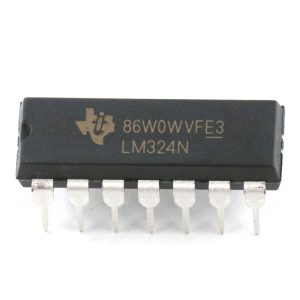Introduction to LM324/324A Operational Amplifiers
Texas Instruments’ LM324/324A devices are a powerful solution for engineers and hobbyists alike. These operational amplifiers consist of four independent high-gain-frequency-compensated op-amps, designed to function efficiently from either single-supply or split-supply sources over a broad range of voltages. Their versatility and reliability make them an essential component in various electronic applications.

Wide Supply Ranges
The LM324/324A operational amplifiers are designed to operate within a wide range of supply voltages, making them highly adaptable. They can function with single supplies ranging from 3 V to 32 V and dual supplies from ±1.5 V to ±16 V. This flexibility allows them to be integrated into a variety of circuits, whether you’re working with low-voltage battery-operated devices or more substantial power sources.
Low Supply-Current Drain
One of the standout features of the LM324/324A is its low supply-current drain. At a typical value of 0.8 mA, this current drain is independent of the supply voltage magnitude. This efficiency ensures that the amplifiers do not place excessive demand on the power supply, making them ideal for energy-sensitive applications and enhancing the overall longevity of battery-operated devices.
Common-Mode Input Voltage Range and Differential Input Voltage Range
The LM324/324A amplifiers offer a common-mode input voltage range that includes ground, allowing for direct sensing near ground levels. This capability is crucial for applications that require accurate ground-referenced signal processing. Additionally, the differential input voltage range is equal to the maximum-rated supply voltage of 32 V, providing robust performance in high-voltage environments and ensuring reliable operation across various scenarios.
Enhanced Protection and Low Bias Parameters
With a 2 kV electrostatic discharge (ESD) protection, the LM324/324A devices are safeguarded against unexpected electrical discharges, ensuring durability and reliability. They also boast low input bias and offset parameters. The typical input offset voltage is 3 mV, reduced to 2 mV in the A versions, while the input offset current is 2 nA typical (15 nA for A versions), and the input bias current is 20 nA typical (15 nA for A versions). These low bias parameters enhance the precision and accuracy of signal amplification.
High Voltage Amplification and Internal Frequency Compensation
These operational amplifiers deliver impressive open-loop differential voltage amplification, typically around 100 V/mV. This high level of amplification makes them suitable for applications requiring significant signal gain. Furthermore, the internal frequency compensation simplifies the design process by ensuring stability across a wide range of operating conditions, allowing for more straightforward circuit integration.
Conclusion
The Texas Instruments’ LM324/324A operational amplifiers are a versatile and reliable choice for a wide range of electronic applications. Their wide supply ranges, low supply-current drain, extensive input voltage ranges, robust protection, low bias parameters, and high voltage amplification capabilities make them indispensable in both simple and complex circuits. Whether you’re designing transducer amplifiers, DC amplification blocks, or conventional operational-amplifier circuits, the LM324/324A devices provide the performance and reliability needed for successful implementations.
Want to Buy
FAQ
Q1: What is the typical supply voltage range for the LM324/324A?
A1: The LM324/324A operational amplifiers can operate with a single supply voltage range of 3 V to 32 V and dual supply voltage ranges of ±1.5 V to ±16 V.
Q2: How much current do these operational amplifiers typically draw?
A2: The LM324/324A devices typically draw a supply-current of 0.8 mA, independent of the supply voltage.
Q3: Can these amplifiers be used for ground-referenced signal processing?
A3: Yes, the LM324/324A amplifiers have a common-mode input voltage range that includes ground, making them suitable for direct sensing near ground levels.
Q4: What protection do the LM324/324A devices offer against electrostatic discharge?
A4: These operational amplifiers provide 2 kV electrostatic discharge (ESD) protection.
Q5: What are the typical input offset voltage and current for these amplifiers?
A5: The typical input offset voltage is 3 mV (2 mV for A versions), and the typical input offset current is 2 nA (15 nA for A versions). The input bias current is 20 nA typical (15 nA for A versions).
Q6: What level of voltage amplification do the LM324/324A devices provide?
A6: The LM324/324A operational amplifiers offer an impressive open-loop differential voltage amplification of approximately 100 V/mV.
Q7: Are the LM324/324A amplifiers internally frequency compensated?
A7: Yes, these amplifiers include internal frequency compensation, which ensures stability and simplifies circuit design.
